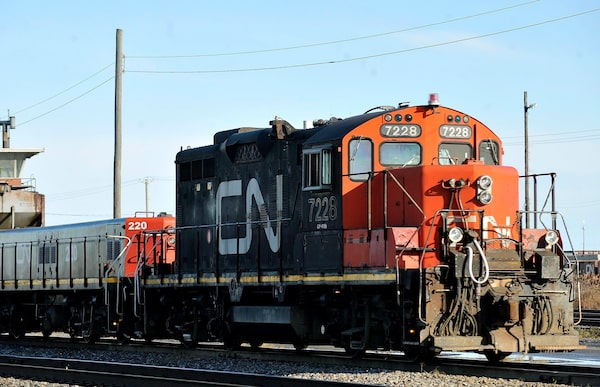
Weekly data compiled by the Canadian Pacific and Canadian National railways show that since April, things haven’t gotten appreciably better – even as the recovery elsewhere in the economy has continued.Graham Hughes/The Canadian Press
As the Canadian economy gradually returns to a semblance of sort-of, kind-of normal, the evidence continues to mount that we’re undergoing quite a remarkable rebound. Thanks to the growing use of new technology to track activity in close to real time, we can see that much of consumer activity has rapidly recovered as containment restrictions ease – by some measures, even exceeding prepandemic levels.
But there’s a decidedly old-school measure of economic activity that is flashing a caution signal that the high-tech data sources are missing. It comes from the railways, which can still tell us a thing or two that Google’s mobility tracker and online restaurant reservations can’t.
Those rail numbers indicate that while consumers may be bouncing back quickly, producers are not – especially many of the most export-dependent producers.
Statistics Canada’s May rail car loadings report, released Wednesday, shows that even as things such as jobs and retail sales bounced back sharply as the strictest of the lockdowns ended, rail shipments showed essentially no improvement, and remained in the deep hole into which they had sunk in April, more than 13 per cent below year-earlier levels. Weekly data compiled by the Canadian Pacific and Canadian National railways themselves show that since then, things haven’t gotten appreciably better – even as the recovery elsewhere in the economy has continued.
For the first three weeks of July, CP’s carloads were down 12 per cent from the same period a year earlier; CN’s were down 10 per cent. Revenue ton-miles (RTMs) – a metric that takes into account both shipping volumes and distance transported – were down 12 per cent at CP and 16 per cent at CN. RTMs at both railways are little changed from mid-April, generally regarded as the economic low point of the crisis.
The rail statistics are at odds with other signs of economic recovery from what are often referred to as high-frequency indicators – which are available more often and with a shorter time lag than more traditional economic indicators. Banking data on electronic payment transactions, for example, show that by mid-July, both consumer and business transactions had surpassed year-ago levels. While at least some of that may reflect the COVID-driven shift in preference to no-touch card payments rather than cash, the rebound is backed up by Statscan’s own recent retail sales estimate, which indicated that consumer spending had returned to very close to prepandemic levels in June.
A deeper examination of the railways’ weekly data reveals that a great deal of the slump in rail shipments can be linked to the country’s big commodity-export mainstays, less so to food and consumer goods. So the weakness reflects continued poor export demand, rather than the domestic consumption that other data indicate has recovered much more strongly.
The continued lag in rail shipments relative to the consumer economy also tells us something about the effectiveness of government supports to offset the damage from the COVID shutdowns. Its direct payments to consumers, mainly by the Canada Emergency Response Benefit (CERB), have served to maintain incomes through the crisis – including in a period where widespread retail closings naturally forced a reduction in spending. As stores have reopened, consumers were both willing and able to unleash spending that had been delayed by the lockdowns.
That appears to have put the consumer recovery ahead of the game – and, quite possibly, ahead of where it realistically would be without a massive injection of spending money courtesy of Ottawa.
The rail numbers suggest that for the country’s most export-sensitive goods producers, the story still looks very different. Their markets remain strained by containment measures and economic slowdowns. Their businesses can’t be helped much by Ottawa’s household income supports. Their recovery looks to be on a very different trajectory.
That, of course, is sure to weigh on the consumer sector over longer term. Jobs related to key commodity export industries and supporting businesses will not come back as they will in other sectors; households that relied on those incomes will be hit, consumption will face strains. It’s a key reason to expect that the initial rebound from the lockdowns will give way to a slower and more difficult economic recovery over the next year or two.
Your time is valuable. Have the Top Business Headlines newsletter conveniently delivered to your inbox in the morning or evening. Sign up today.